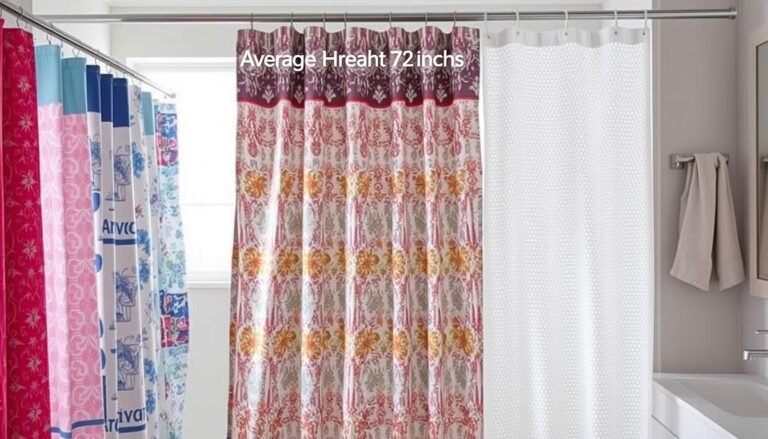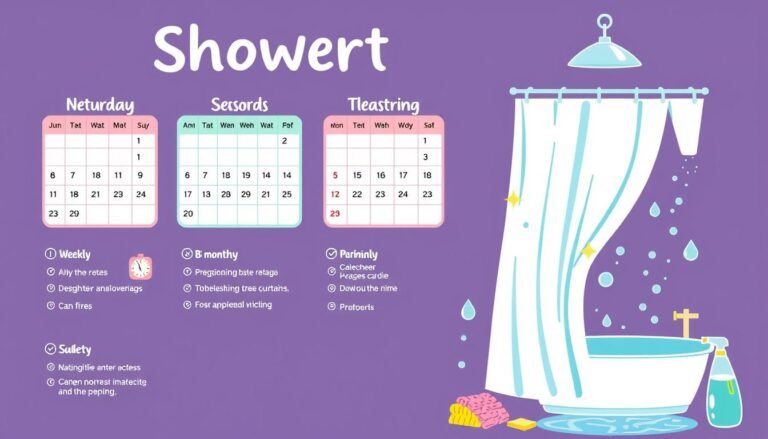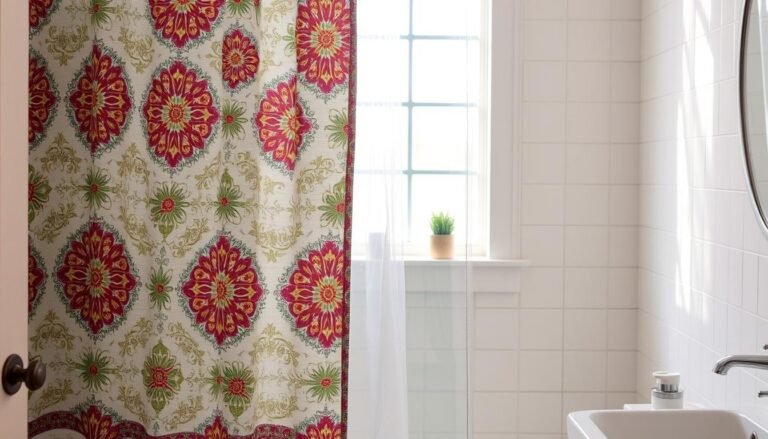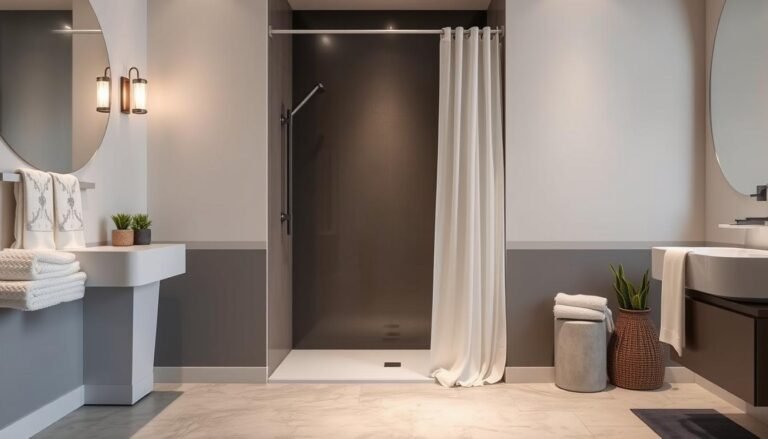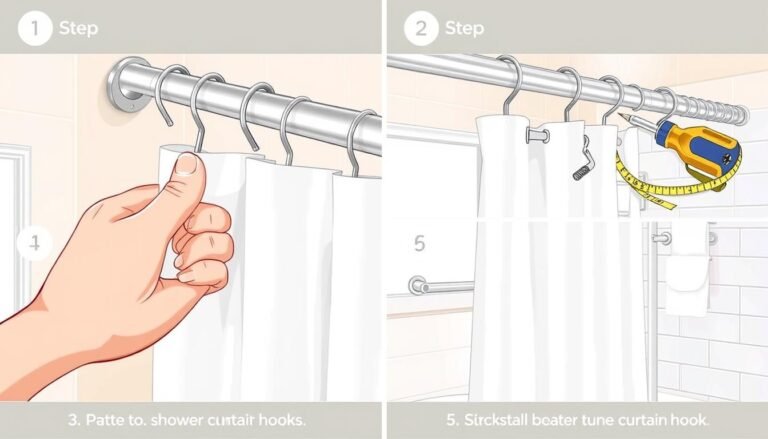Why Europeans Skip Shower Curtains Explained
Traveling through Europe, you’ll notice fewer shower curtains in bathrooms. This is a shock to many, especially in places like London. The city’s efficient public transport contrasts with its tricky showers. For example, a hotel in Bloomsbury might have a shower with just a partial glass pane. This leads to water everywhere, a staple of European bathroom culture.
From Italy to Hungary, you might spot these half glass dividers too. They make showering a challenge. Yet, the easy fix of a shower curtain is often overlooked. It makes you question the shower practices in Europe.
In Ireland, some showers work with a pull cord, which looks like an emergency device. These unique setups confuse many travelers. Especially Americans, who find them odd. The cultural differences in bathroom designs are quite clear.
Tall folks in Switzerland struggle with these showers. The partial glass doors don’t keep water in. Despite the clear benefits of shower curtains, they’re rare in Europe. This curiosity sheds light on the varied shower customs there.
Introduction to European Bathroom Culture
European shower habits and bathroom decor have roots in history and culture. We need to explore these origins to grasp today’s practices. This journey takes us back to early European bathing and its influences on modern bathrooms.
Historical Background
In ancient Greece and Rome, people enjoyed olive oil baths and skincare with rosewater-soaked wool. The Romans had over 800 public baths at one time. This shows how important communal baths were to them. But, bathing took a hit in the Middle Ages in Europe.
Soap, brought from the East by crusaders, was used despite the decline of bathing. Public bathhouses stayed popular, impacting today’s shower habits. It was a different time with unique practices.
The 1850s brought plumbed bathrooms, changing everything. This made bathing more private and indoor. It was a big step from ancient baths to medieval communal practices, showing hygiene’s evolution.
Cultural Influences on Modern Bathrooms
Today’s European bathrooms blend history with modern design. In the past, people washed clothes less and used unique methods, like urine for stains. But using linen to soak up sweat showed an early lean towards hygiene.
Modern bathrooms in Europe are usually small and efficient. This is due to old city rules and the need to save space. Half-shower doors are popular for their style and practicality. They show how Europe’s past shapes current designs and values.
Differences in Bathroom Design Between Europe and the U.S.
Looking into the differences in bathroom design between Europe and the U.S. shows us unique architectural and cultural tastes. These differences shape what you expect when you travel or buy a house.
Structural Variations
In bathroom design, one big divide is between shower curtains and glass divisions. While some prefer shower curtains, others don’t like how they stick or are hard to clean. In Europe, showers often have glass barriers or screens. They keep water in without ruining the look. Choosing glass or half doors says a lot about engineering tastes and aims for better hygiene and ease of use.
Design Aesthetics
European bathrooms often go for a sleek, minimal look. Without shower curtains, they feel more open, thanks to stylish glass panels. Europe also likes tech-forward showers that blend design and function. American bathrooms, however, usually have bathtubs and basic showerheads.
Material Choices
Materials in bathrooms also show different regional styles. European bathrooms tend to have quality glass doors and fancy fixtures. They like hand showers that can be low or in holders, unlike the U.S.’s fixed ones. This choice boosts both function and eco-friendliness. It’s common in Europe not to change towels daily, to save resources.
- European places use glass panels or doors against water leaks.
- Europe prefers handheld showers for their handy and flexible use.
- European hotels often skip washcloths, thinking eco-first.
- They don’t change towels each day to be more green.
Shared toilets and showers can be found “down the hall” in cheaper European spots. Yet, many now offer some rooms with private baths, merging old and new perks. This shows the balance European designs make between functionality and user experience in their bathrooms.
| Feature | Europe | U.S. |
|---|---|---|
| Shower Enclosures | Partial Glass Panels | Shower Curtains |
| Shower Type | Handheld Showers | Fixed Showers |
| Eco-Friendly Practices | Towel Replacement Frequency | Frequent Replacement |
Practicality and Functionality in European Shower Designs
Practical design in European bathrooms is all about being functional. Many European hotels choose clever options, like half-shower doors or no doors at all. This is because there’s often not much room. These designs help make even the tiniest spaces look open and airy.
Some travelers from the U.S. might find the open showers odd. They miss the privacy that curtains or full doors provide. Yet, the idea behind showers in Europe is to be both efficient and clean. Glass doors, especially without frames, are simpler to keep clean. They help avoid mold and make it quicker to get rooms ready for new guests.
How water is handled is key in European shower functionality. Many bathrooms have floors that slope slightly to guide water to the drain. This design lessens spillage and makes it safer to use. You’ll also often see non-slip mats, grab bars, and showers you can adjust. These features make sure guests are safe and comfortable.
Here’s a quick look at different shower designs found in European hotels:
| Design Element | Advantages | Challenges |
|---|---|---|
| Half-Shower Doors | Creates space illusion, modern aesthetic | Potential for water escape, less privacy |
| Frameless Glass Doors | Reduces mold, easier to clean | Requires more cleaning due to water spots |
| Door-less Showers | Enhanced brightness, seamless access | Increased chance of wet floors, safety concerns |
| Adjustable Shower Heads | Customizable water pressure, targeted spray | May require frequent adjustments by guests |
The focus on practical design and functionality in European bathrooms brings fresh design challenges. Not having traditional shower doors can make the room wetter, especially in minimalist styles. But these designs adapt and improve over time. They aim to make the bathroom experience better and safer for everyone.
Why Don’t Europeans Use Shower Curtains?
Many travelers are surprised by the lack of shower curtains in Europe. This is because Europeans often prefer different solutions. These options add a special touch to European bathrooms.
Alternative Solutions
European bathrooms might not have regular shower curtains. Instead, they use high-tech shower systems. These systems make bathing more enjoyable. Compared to simple shower curtains, these options show how diverse European taste is. Also, European Airbnb places might have curtains or doors. However, you won’t find these in many hotels.
Environmental Considerations
Europeans often skip shower curtains for greener choices. They aim to use fewer materials and choose durable options. This matches Europe’s strong focus on the environment. By choosing long-lasting bathroom fixtures, Europeans help reduce waste. They also support eco-friendly efforts at home. This choice shows a deep care for the environment and smart design.
Travelers have mixed feelings about European showers. 14 travelers found them hard to use, while 9 saw the setups as challenging. Yet, many European homes keep using curtains or doors. This shows a mix of old and new styles in bathroom design.
Cultural Norms Around Showers in Europe
Exploring European shower habits reveals unique norms in bathroom practices. People’s daily routines and public vs. private bathing preferences differ greatly from those in America. This highlights cultural variations that impact shower setups and expectations.
Daily Shower Habits
In Europe, daily shower habits stand out from other regions. For example, in Spain, removable showerheads are more common than fixed ones. This preference is largely because of the need to save water, as water costs can be high.
Also, “wet showers,” seen in some European countries, don’t have a clear separation from the rest of the bathroom. This design means Europeans often need to control the water spray more efficiently. It lessens the need for shower curtains.
Public vs. Private Bathing Practices
The cultural norms around public and private bathing in Europe offer interesting contrasts. For instance, communal saunas are essential in Finnish culture. But in private homes, especially in France, baths with sit-down showers are preferred. This approach often removes the need for shower curtains.
European hotel bathroom designs also reflect these cultural practices. Bathrooms typically have walk-in showers with handheld showerheads and glass doors. This setup aims to save space and water and control water splash more effectively.
The differences in European shower habits and the distinct approaches to public and private bathing underscore the cultural heritage. These practices, from water conservation to communal bathing, shape Europe’s unique bathroom culture.
The Advantages of Shower Screens and Glass Panels
Shower screens and glass panels are popular in modern European bathrooms. They offer benefits that improve the look and function of the space.
Design Appeal
Glass panels are known for their design appeal. They give a clean, modern look that enhances both walk-in showers and tub combinations. Unlike shower curtains, glass panels have a sleek, minimal style.
Their clear look increases the sense of space, making small bathrooms seem bigger. This creates a more open environment.
- Glass doors are almost always preferable for stand-alone, walk-in showers.
- Glass panels provide a clean, modern appearance for combination tub and shower setups.
- The trend of open bathrooms enhances the overall brightness and spaciousness.
Maintenance and Cleaning
Keeping European showers clean, especially those with glass panels, requires regular care. However, they are easier to clean than shower curtains. Fabric shower curtains can hold mold and mildew, needing more frequent changes. Glass enclosures don’t absorb moisture, so they’re less likely to grow mold.
Non-grouted wet room systems and laminated shower wall panels make shower maintenance easier. They keep modern showers looking neat with less effort.
| Feature | Shower Screens | Shower Curtains |
|---|---|---|
| Visual Appeal | Modern, sleek, and spacious | Traditional, often bulky |
| Maintenance | Easy to clean, minimal mold | Frequent cleaning, prone to mold |
| Durability | Long-lasting | Requires regular replacement |
| Functionality | Efficient water containment | Can lead to water spillage |
In the end, shower screens’ advantages and the design appeal of glass panels make them the top choice. They keep modern European showers beautiful and clean.
Regional Variations in Shower Setups Across Europe
Europe has a wide range of shower preferences that show its rich bathroom design traditions. Scandinavia boasts minimalist and functional showers. Meanwhile, southern Europe prefers ornate and luxurious ones. As you travel across Ireland, Italy, or Switzerland, you’ll see how different each shower can be.
In Ireland and Italy, bathroom designs show how varied European styles are. Irish bathrooms are elegant and often use local materials. Italian ones, however, are grand and use marble and detailed tiles.
In Switzerland, shower styles change from one region to another. Urban hotels might have modern, glass showers. Countryside inns, on the other hand, go for rustic, open-plan ones. This shows the need to adapt designs to local tastes and needs. For renovation ideas, consider looking into regional preferences and functional requirements.
Understanding these design differences is key for any renovation or new project. Knowing about regional specifics helps achieve both function and beauty in design. It also lets you appreciate the influence of European cultures on bathroom styles. For tips on making your bathroom stand out, explore resources that offer design insights and expert advice.

Hey there, I’m Alex Hanson and I’m passionate about all things covers! Whether you’re looking for a car seat cover to protect your vehicle or an oven cover to keep your kitchen clean, I’m here to help. With years of experience in the industry, I have plenty of knowledge and insights to share with my readers. So, if you care about protecting your belongings and making them look their best, you’re encouraged to read my blog as I explore the perfect cover for every need.


